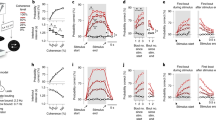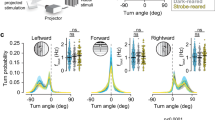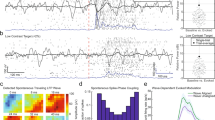Abstract
In a neural integrator, the variability and topographical organization of neuronal firing-rate persistence can provide information about the circuit's functional architecture. We used optical recording to measure the time constant of decay of persistent firing (persistence time) across a population of neurons comprising the larval zebrafish oculomotor velocity-to-position neural integrator. We found extensive persistence time variation (tenfold; coefficients of variation = 0.58–1.20) across cells in individual larvae. We also found that the similarity in firing between two neurons decreased as the distance between them increased and that a gradient in persistence time was mapped along the rostrocaudal and dorsoventral axes. This topography is consistent with the emergence of persistence time heterogeneity from a circuit architecture in which nearby neurons are more strongly interconnected than distant ones. Integrator circuit models characterized by multiple dimensions of slow firing-rate dynamics can account for our results.
This is a preview of subscription content, access via your institution
Access options
Subscribe to this journal
Receive 12 print issues and online access
$209.00 per year
only $17.42 per issue
Buy this article
- Purchase on Springer Link
- Instant access to full article PDF
Prices may be subject to local taxes which are calculated during checkout








Similar content being viewed by others
References
Robinson, D.A. Integrating with neurons. Annu. Rev. Neurosci. 12, 33–45 (1989).
Oestreich, J., Dembrow, N.C., George, A.A. & Zakon, H.H. A “sample-and-hold” pulse-counting integrator as a mechanism for graded memory underlying sensorimotor adaptation. Neuron 49, 577–588 (2006).
Huk, A.C. & Shadlen, M.N. Neural activity in macaque parietal cortex reflects temporal integration of visual motion signals during perceptual decision making. J. Neurosci. 25, 10420–10436 (2005).
Taube, J.S. & Bassett, J.P. Persistent neural activity in head direction cells. Cereb. Cortex 13, 1162–1172 (2003).
Cohen, B. & Komatsuzaki, A. Eye movements induced by stimulation of the pontine reticular formation: evidence for integration in oculomotor pathways. Exp. Neurol. 36, 101–117 (1972).
Skavenski, A.A. & Robinson, D.A. Role of abducens neurons in vestibuloocular reflex. J. Neurophysiol. 36, 724–738 (1973).
Major, G. & Tank, D. Persistent neural activity: prevalence and mechanisms. Curr. Opin. Neurobiol. 14, 675–684 (2004).
Lopez-Barneo, J., Darlot, C., Berthoz, A. & Baker, R. Neuronal activity in prepositus nucleus correlated with eye movement in the alert cat. J. Neurophysiol. 47, 329–352 (1982).
McFarland, J.L. & Fuchs, A.F. Discharge patterns in nucleus prepositus hypoglossi and adjacent medial vestibular nucleus during horizontal eye movement in behaving macaques. J. Neurophysiol. 68, 319–332 (1992).
Aksay, E., Baker, R., Seung, H.S. & Tank, D.W. Anatomy and discharge properties of pre-motor neurons in the goldfish medulla that have eye-position signals during fixations. J. Neurophysiol. 84, 1035–1049 (2000).
Seung, H.S. How the brain keeps the eyes still. Proc. Natl. Acad. Sci. USA 93, 13339–13344 (1996).
Machens, C.K., Romo, R. & Brody, C.D. Flexible control of mutual inhibition: a neural model of two-interval discrimination. Science 307, 1121–1124 (2005).
Singh, R. & Eliasmith, C. Higher-dimensional neurons explain the tuning and dynamics of working memory cells. J. Neurosci. 26, 3667–3678 (2006).
Seung, H.S., Lee, D.D., Reis, B.Y. & Tank, D.W. Stability of the memory of eye position in a recurrent network of conductance-based model neurons. Neuron 26, 259–271 (2000).
Koulakov, A.A., Raghavachari, S., Kepecs, A. & Lisman, J.E. Model for a robust neural integrator. Nat. Neurosci. 5, 775–782 (2002).
Goldman, M.S., Levine, J.H., Major, G., Tank, D.W. & Seung, H.S. Robust persistent neural activity in a model integrator with multiple hysteretic dendrites per neuron. Cereb. Cortex 13, 1185–1195 (2003).
Anastasio, T.J. The fractional-order dynamics of brainstem vestibulo-oculomotor neurons. Biol. Cybern. 72, 69–79 (1994).
Major, G., Baker, R., Aksay, E., Seung, H.S. & Tank, D.W. Plasticity and tuning of the time course of analog persistent firing in a neural integrator. Proc. Natl. Acad. Sci. USA 101, 7745–7750 (2004).
Maass, W., Joshi, P. & Sontag, E.D. Computational aspects of feedback in neural circuits. PLOS Comput. Biol. 3, e165 (2007).
Aksay, E. et al. Functional dissection of circuitry in a neural integrator. Nat. Neurosci. 10, 494–504 (2007).
Cannon, S.C., Robinson, D.A. & Shamma, S. A proposed neural network for the integrator of the oculomotor system. Biol. Cybern. 49, 127–136 (1983).
Goldman, M.S. Memory without feedback in a neural network. Neuron 61, 621–634 (2009).
Miri, A., Daie, K., Burdine, R.D., Aksay, E. & Tank, D.W. Regression-based identification of behavior-encoding neurons during large-scale optical imaging of neural activity at cellular resolution. J. Neurophysiol. 105, 964–980 (2011).
McLean, D.L., Fan, J., Higashijima, S., Hale, M.E. & Fetcho, J.R. A topographic map of recruitment in spinal cord. Nature 446, 71–75 (2007).
Weiler, N., Wood, L., Yu, J., Solla, S.A. & Shepherd, G.M. Top-down laminar organization of the excitatory network in motor cortex. Nat. Neurosci. 11, 360–366 (2008).
Higashijima, S., Mandel, G. & Fetcho, J.R. Distribution of prospective glutamatergic, glycinergic and GABAergic neurons in embryonic and larval zebrafish. J. Comp. Neurol. 480, 1–18 (2004).
Dasen, J.S. & Jessell, T.M. Hox networks and the origins of motor neuron diversity. Curr. Top. Dev. Biol. 88, 169–200 (2009).
Pastor, A.M., de La Cruz, R.R. & Baker, R. Eye position and eye velocity integrators reside in separate brainstem nuclei. Proc. Natl. Acad. Sci. USA 91, 807–811 (1994).
Arrenberg, A.B., Del Bene, F. & Baier, H. Optical control of zebrafish behavior with halorhodopsin. Proc. Natl. Acad. Sci. USA 106, 17968–17973 (2009).
Schoonheim, P.J., Arrenberg, A.B., Del Bene, F. & Baier, H. Optogenetic localization and genetic perturbation of saccade-generating neurons in zebrafish. J. Neurosci. 30, 7111–7120 (2010).
Escudero, M., de la Cruz, R.R. & Delgado-Garcia, J.M. A physiological study of vestibular and prepositus hypoglossi neurones projecting to the abducens nucleus in the alert cat. J. Physiol. (Lond.) 458, 539–560 (1992).
Aksay, E., Baker, R., Seung, H.S. & Tank, D.W. Correlated discharge among cell pairs within the oculomotor horizontal velocity-to-position integrator. J. Neurosci. 23, 10852–10858 (2003).
Shinoda, Y. & Yoshida, K. Dynamic characteristics of responses to horizontal head angular acceleration in vestibuloocular pathway in the cat. J. Neurophysiol. 37, 653–673 (1974).
Anastasio, T.J. Nonuniformity in the linear network model of the oculomotor integrator produces approximately fractional-order dynamics and more realistic neuron behavior. Biol. Cybern. 79, 377–391 (1998).
Aksay, E. et al. History dependence of rate covariation between neurons during persistent activity in an oculomotor integrator. Cereb. Cortex 13, 1173–1184 (2003).
Debowy, O. & Baker, R. Encoding of eye position in the goldfish horizontal oculomotor neural integrator. J. Neurophysiol. 105, 896–909 (2011).
Sklavos, S., Porrill, J., Kaneko, C.R. & Dean, P. Evidence for wide range of time scales in oculomotor plant dynamics: implications for models of eye-movement control. Vision Res. 45, 1525–1542 (2005).
Kinkhabwala, A. et al. A structural and functional ground plan for neurons in the hindbrain of zebrafish. Proc. Natl. Acad. Sci. USA 108, 1164–1169 (2011).
McLean, D.L., Masino, M.A., Koh, I.Y., Lindquist, W.B. & Fetcho, J.R. Continuous shifts in the active set of spinal interneurons during changes in locomotor speed. Nat. Neurosci. 11, 1419–1429 (2008).
Goldberg, J.M. & Fernandez, C. Physiology of peripheral neurons innervating semicircular canals of the squirrel monkey. I. Resting discharge and response to constant angular acceleration. J. Neurophysiol. 34, 635–660 (1971).
Miles, F.A. & Braitman, D.J. Long-term adaptive changes in primate vestibuloocular reflex. II. Electrophysiological observations on semicircular canal primary afferents. J. Neurophysiol. 43, 1426–1436 (1980).
Sussillo, D. & Abbott, L.F. Generating coherent patterns of activity from chaotic neural networks. Neuron 63, 544–557 (2009).
Helmstaedter, M., Briggman, K.L. & Denk, W. 3D structural imaging of the brain with photons and electrons. Curr. Opin. Neurobiol. 18, 633–641 (2008).
Beck, J.C., Rothnie, P., Straka, H., Wearne, S.L. & Baker, R. Precerebellar hindbrain neurons encoding eye velocity during vestibular and optokinetic behavior in the goldfish. J. Neurophysiol. 96, 1370–1382 (2006).
Ma, L.H., Punnamoottil, B., Rinkwitz, S. & Baker, R. Mosaic hoxb4a neuronal pleiotropism in zebrafish caudal hindbrain. PLoS ONE 4, e5944 (2009).
Huang, Z. Membrane potential fluctuations in a neural integrator. PhD thesis, Princeton University (2009).
Aksay, E., Gamkrelidze, G., Seung, H.S., Baker, R. & Tank, D.W. In vivo intracellular recording and perturbation of persistent activity in a neural integrator. Nat. Neurosci. 4, 184–193 (2001).
Teramae, J.N. & Fukai, T. A cellular mechanism for graded persistent activity in a model neuron and its implications in working memory. J. Comput. Neurosci. 18, 105–121 (2005).
Fransén, E., Tahvildari, B., Egorov, A.V., Hasselmo, M.E. & Alonso, A.A. Mechanism of graded persistent cellular activity of entorhinal cortex layer V neurons. Neuron 49, 735–746 (2006).
Loewenstein, Y. & Sompolinsky, H. Temporal integration by calcium dynamics in a model neuron. Nat. Neurosci. 6, 961–967 (2003).
Acknowledgements
We thank D. Dombeck for technical advice, F. Collman for motion-correction software, and M. Goldman, A. Kinkhabwala and P. Bradley for helpful discussions. This work was supported by a National Science Foundation predoctoral fellowship (A.M.), a US National Institutes of Health Training grant (EY007138-16, K.D.), a Krevans fellowship (A.B.A.), a Burroughs Wellcome Career Award at the Scientific Interface, a Searle Scholar award, the Frueauff Foundation (E.A.), the Human Frontier Science Program (H.B.), and US National Institutes of Health grants (R01 MH060651 to D.W.T. and R01 NS053358 to H.B.).
Author information
Authors and Affiliations
Contributions
A.M. collected functional imaging and electrical recording data under the supervision of D.W.T.; A.M., E.A. and D.W.T. developed the preparation, experimental procedures and instrumentation for the imaging and electrophysiological studies; A.M. and K.D. analyzed this data with guidance from E.A. and D.W.T.; A.B.A. and H.B. designed the NpHR study; A.B.A. collected and analyzed the NpHR data; and A.M., K.D., E.A. and D.W.T. wrote the paper.
Corresponding authors
Ethics declarations
Competing interests
The authors declare no competing financial interests.
Supplementary information
Supplementary Text and Figures
Supplementary Figures 1–9 and Supplementary Tables 1 and 2 (PDF 5985 kb)
Rights and permissions
About this article
Cite this article
Miri, A., Daie, K., Arrenberg, A. et al. Spatial gradients and multidimensional dynamics in a neural integrator circuit. Nat Neurosci 14, 1150–1159 (2011). https://doi.org/10.1038/nn.2888
Received:
Accepted:
Published:
Issue Date:
DOI: https://doi.org/10.1038/nn.2888
This article is cited by
-
Thalamus drives vocal onsets in the zebra finch courtship song
Nature (2023)
-
Estimating Fisher discriminant error in a linear integrator model of neural population activity
The Journal of Mathematical Neuroscience (2021)
-
Ramp-to-threshold dynamics in a hindbrain population controls the timing of spontaneous saccades
Nature Communications (2021)
-
Met-Controlled Allosteric Module of Neural Generation as A New Therapeutic Target in Rodent Brain Ischemia
Chinese Journal of Integrative Medicine (2021)
-
Evidence accumulation during a sensorimotor decision task revealed by whole-brain imaging
Nature Neuroscience (2020)



